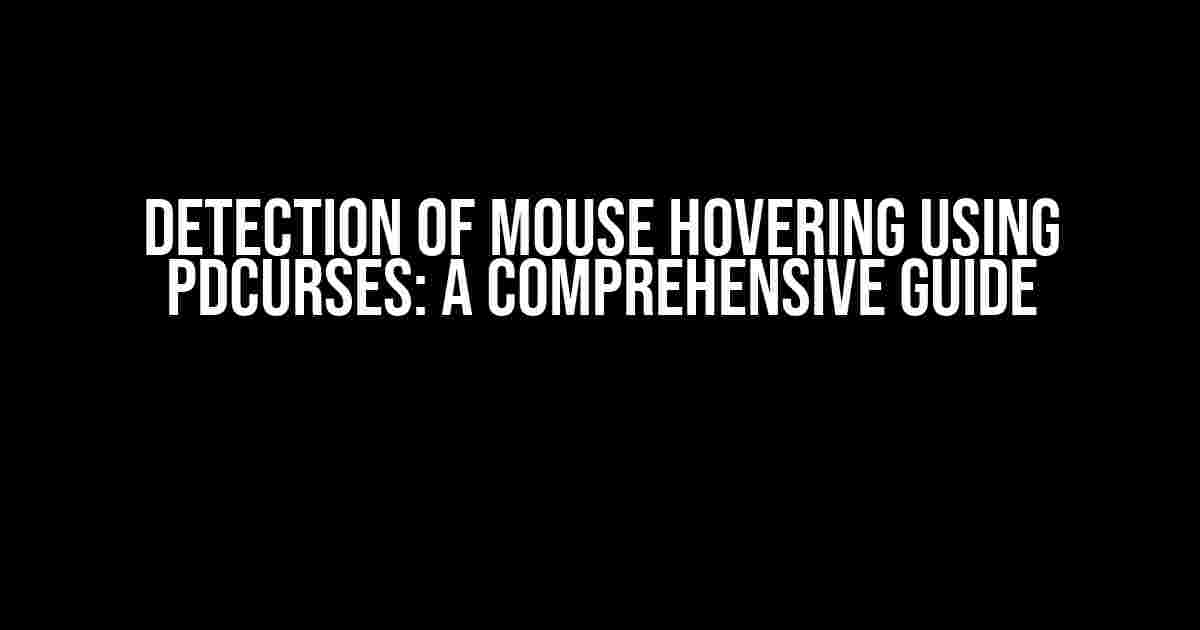Are you tired of creating command-line interfaces that lack the flair of modern graphical user interfaces? Do you want to spice up your text-based applications with some mouse hovering magic? Look no further! In this article, we’ll delve into the world of PDCurses, a popular library for creating text-based user interfaces, and explore the detection of mouse hovering using PDCurses.
What is PDCurses?
PDCurses is a free, open-source library that provides a platform-independent way to create text-based user interfaces. It’s a wrapper around the NCurses library, which is a de facto standard for building text-mode applications. PDCurses offers a wide range of features, including:
- Terminal-independent graphics and text rendering
- Mouse and keyboard event handling
- Window management and border handling
- Text attribute and color management
- And many more!
Why Detect Mouse Hovering?
Detecting mouse hovering is an essential feature in modern user interfaces, as it provides valuable feedback to the user. By detecting when the mouse is hovering over a particular element, you can:
- Highlight or change the appearance of the element
- Display tooltips or additional information
- Trigger actions or events based on the hover state
- Enhance the overall user experience
Setting Up PDCurses
Before we dive into the detection of mouse hovering, let’s get PDCurses set up. Follow these steps to get started:
- Download the PDCurses library from the official website: https://github.com/wmcbrine/PDCurses
- Follow the installation instructions for your platform (Windows, Linux, or macOS)
- Include the PDCurses header file in your C or C++ project:
#include <curses.h> - Initialize the PDCurses library by calling
initscr()andcurs_set(1)
Detecting Mouse Hovering using PDCurses
Now that we have PDCurses set up, let’s explore the detection of mouse hovering. We’ll use the getmouse() function to retrieve the current mouse position and check if it’s within the bounds of a specific element.
#include <curses.h>
int main() {
initscr();
curs_set(1);
// Create a window with a border
WINDOW *win = newwin(10, 20, 2, 2);
box(win, 0, 0);
// Get the initial mouse position
MEVENT event;
getmouse(&event);
// Loop until the user presses a key
while (true) {
// Get the current mouse position
getmouse(&event);
// Check if the mouse is hovering over the window
if (event.x >= 2 && event.x <= 21 && event.y >= 2 && event.y <= 11) {
// Highlight the window by changing its background color
wbkgd(win, COLOR_WHITE);
wrefresh(win);
} else {
// Reset the window's background color
wbkgd(win, COLOR_BLACK);
wrefresh(win);
}
// Wait for a key press
getch();
}
// Clean up
delwin(win);
endwin();
return 0;
}
In this example, we create a window with a border and get the initial mouse position using getmouse(). We then enter a loop where we continuously get the current mouse position and check if it’s within the bounds of the window. If it is, we highlight the window by changing its background color; otherwise, we reset the background color.
Understanding the MEVENT Structure
The MEVENT structure is used to store the mouse event data returned by the getmouse() function. It contains the following members:
| Member | Description |
|---|---|
id |
Mouse event type (e.g., press, release, or motion) |
x |
x-coordinate of the mouse event |
y |
y-coordinate of the mouse event |
| Reserved for future use | |
bstate |
Button state (e.g., left, middle, or right button pressed) |
By examining the MEVENT structure, you can determine the type of mouse event, the coordinates of the event, and the button state.
Common Issues and Solutions
When working with mouse events in PDCurses, you may encounter some common issues. Here are some solutions to get you back on track:
- Issue:** Mouse events are not detected
- Solution:** Make sure to call
mousemask(ALL_MOUSE_EVENTS, NULL)to enable mouse event detection. - Issue:** Mouse coordinates are incorrect
- Solution:** Ensure that you’re using the correct coordinates (0-based or 1-based) depending on your platform. You can use
getmaxyx(stdscr, y, x)to get the maximum coordinates of the standard screen. - Issue:** Window resizing affects mouse event detection
- Solution:** Use
wrefresh()anddoupdate()to update the window and screen after resizing.
Conclusion
Detection of mouse hovering using PDCurses is a powerful feature that can elevate your text-based applications to the next level. By following the steps outlined in this article, you can create intuitive and interactive interfaces that respond to mouse events. Remember to handle common issues and stay creative with your PDCurses projects!
Happy coding!
Here are 5 Questions and Answers about “detection of mouse hovering using pdcurses” in a creative voice and tone:
Frequently Asked Questions
Get the inside scoop on detecting mouse hovering with pdcurses!
How do I enable mouse support in pdcurses?
To enable mouse support in pdcurses, you need to add the `mousemask()` function to your program. This function sets the mouse events that will be reported. For example, `mousemask(ALL_MOUSE_EVENTS, NULL)` will enable reporting of all mouse events. Then, use the `getmouse()` function to retrieve the mouse event and check if the event is a hover event.
What is the difference between a mouse click and a mouse hover event in pdcurses?
In pdcurses, a mouse click event is generated when the user presses a mouse button, while a mouse hover event is generated when the user moves the mouse cursor over a certain area of the screen without clicking. You can distinguish between these two events by checking the `id` field of the `MEVENT` structure returned by `getmouse()`. For example, `id == BUTTON_CLICKED` indicates a click event, while `id == MOUSEMotion` indicates a hover event.
How do I get the coordinates of the mouse cursor in pdcurses?
To get the coordinates of the mouse cursor in pdcurses, you can use the `getmouse()` function, which returns a `MEVENT` structure containing the mouse event information. The `x` and `y` fields of this structure hold the coordinates of the mouse cursor. For example, `MEVENT event; getmouse(&event); printf(“Mouse cursor is at (%d, %d)\n”, event.x, event.y);`.
Can I use pdcurses to detect mouse hovering over a specific area of the screen?
Yes, you can use pdcurses to detect mouse hovering over a specific area of the screen. You can check the coordinates of the mouse cursor returned by `getmouse()` and compare them to the coordinates of the area you’re interested in. For example, if you want to detect hovering over a button with top-left corner at `(10, 10)` and bottom-right corner at `(20, 20)`, you can check if `event.x >= 10 && event.x <= 20 && event.y >= 10 && event.y <= 20`.
Are there any limitations to using pdcurses for mouse hovering detection?
Yes, there are some limitations to using pdcurses for mouse hovering detection. For example, pdcurses only reports mouse events when the mouse is moved or a button is pressed, so you won’t get continuous updates on the mouse cursor position. Additionally, pdcurses may not work properly in all terminals or operating systems, so be sure to test your program thoroughly before releasing it.




